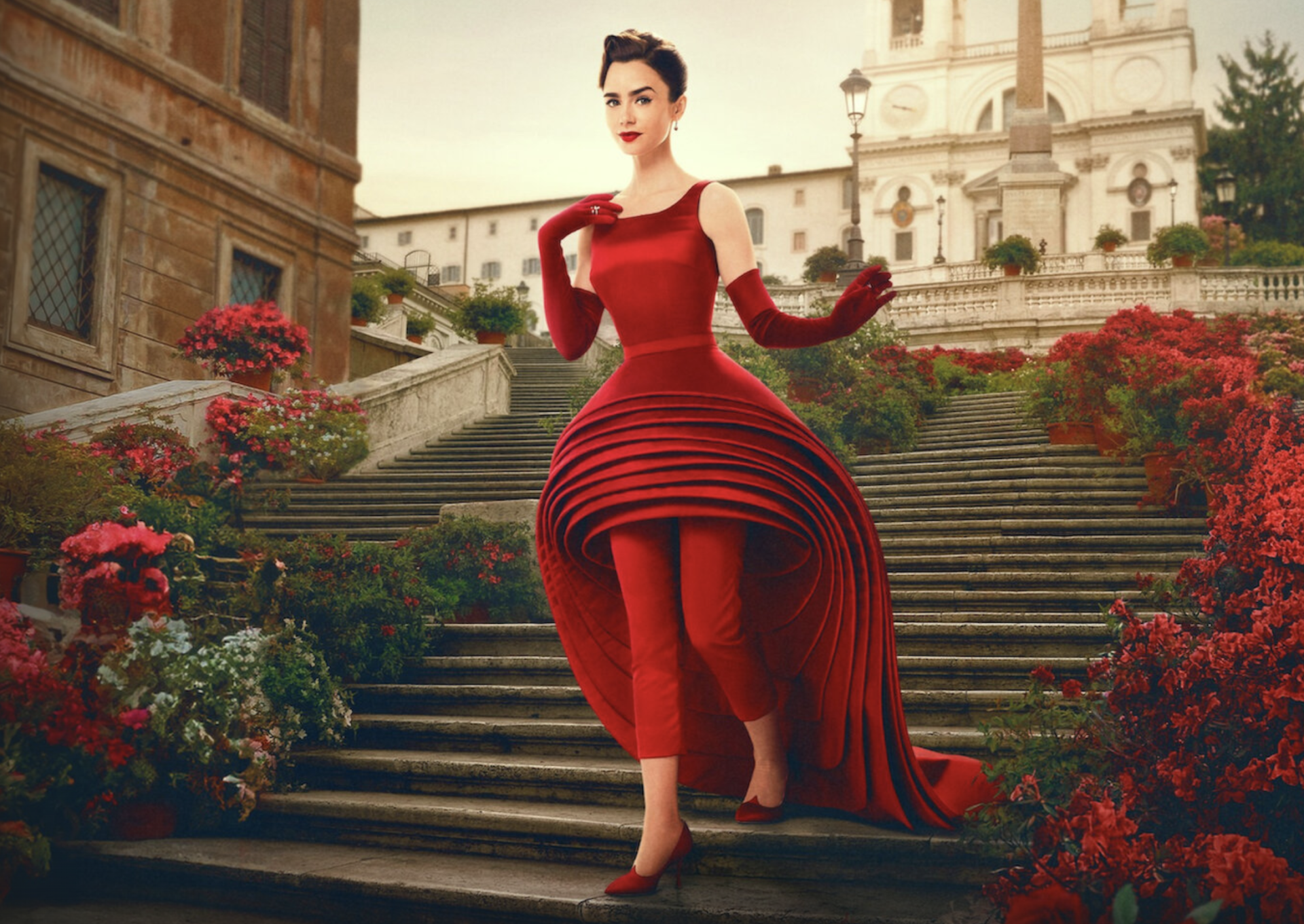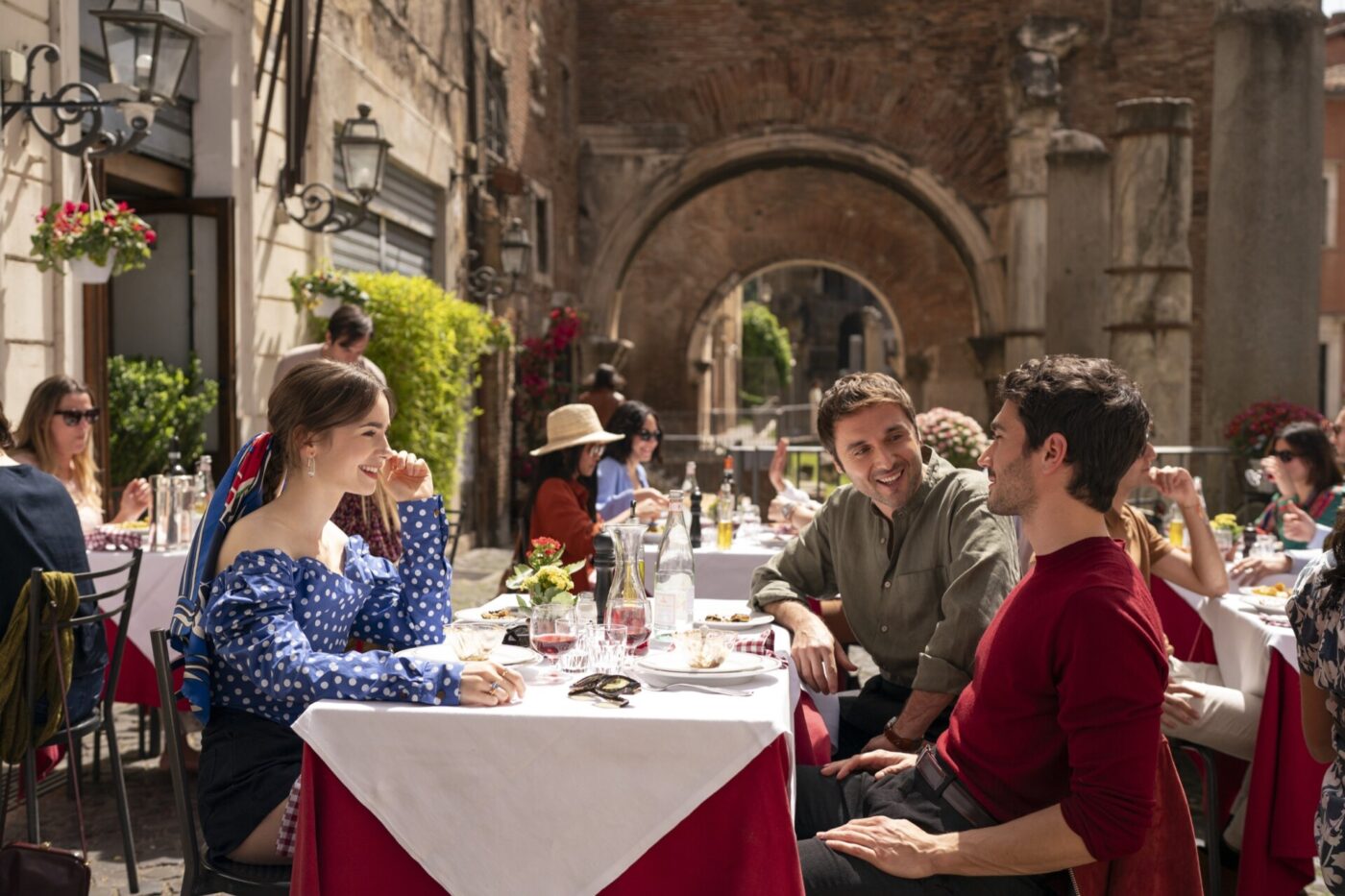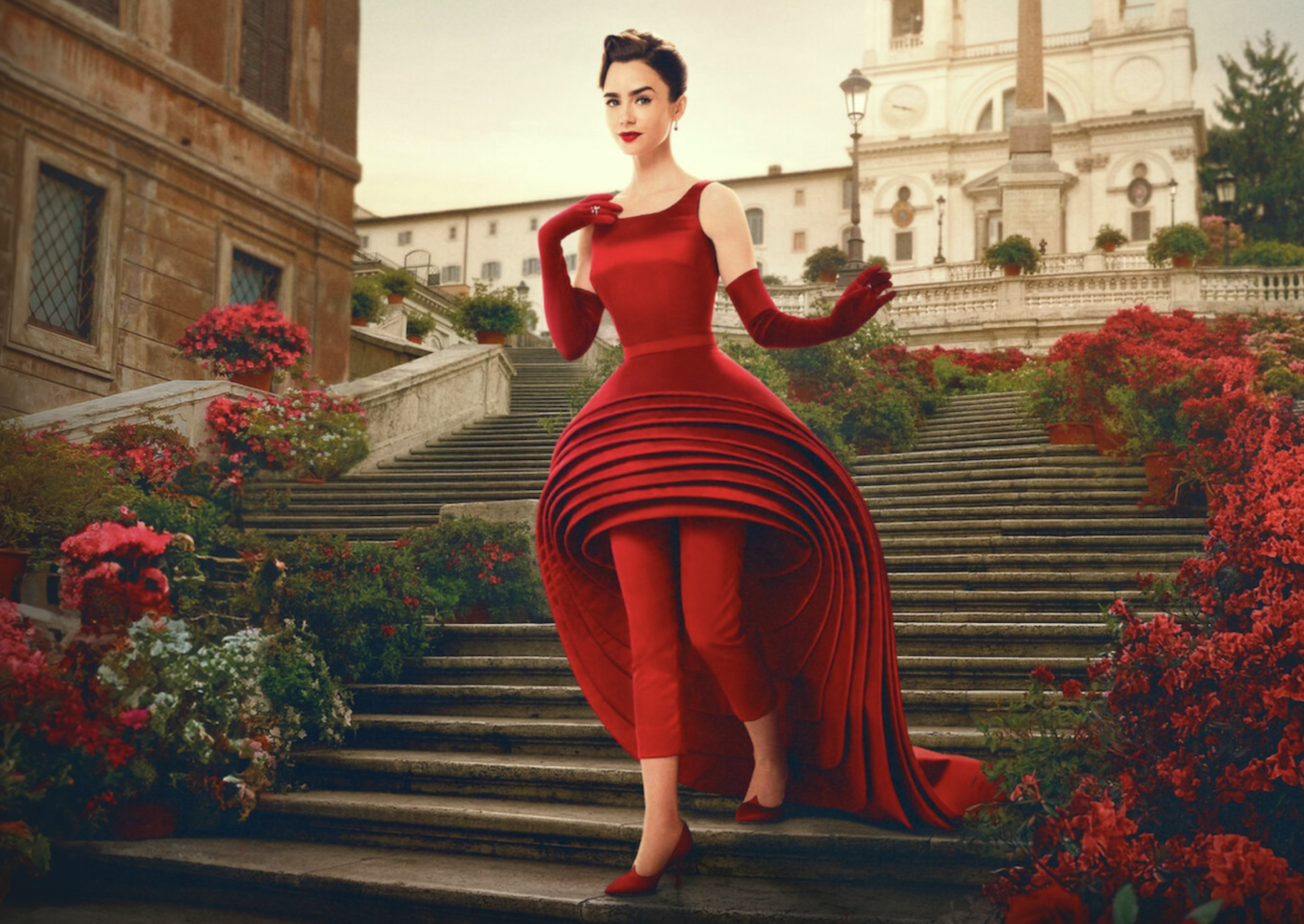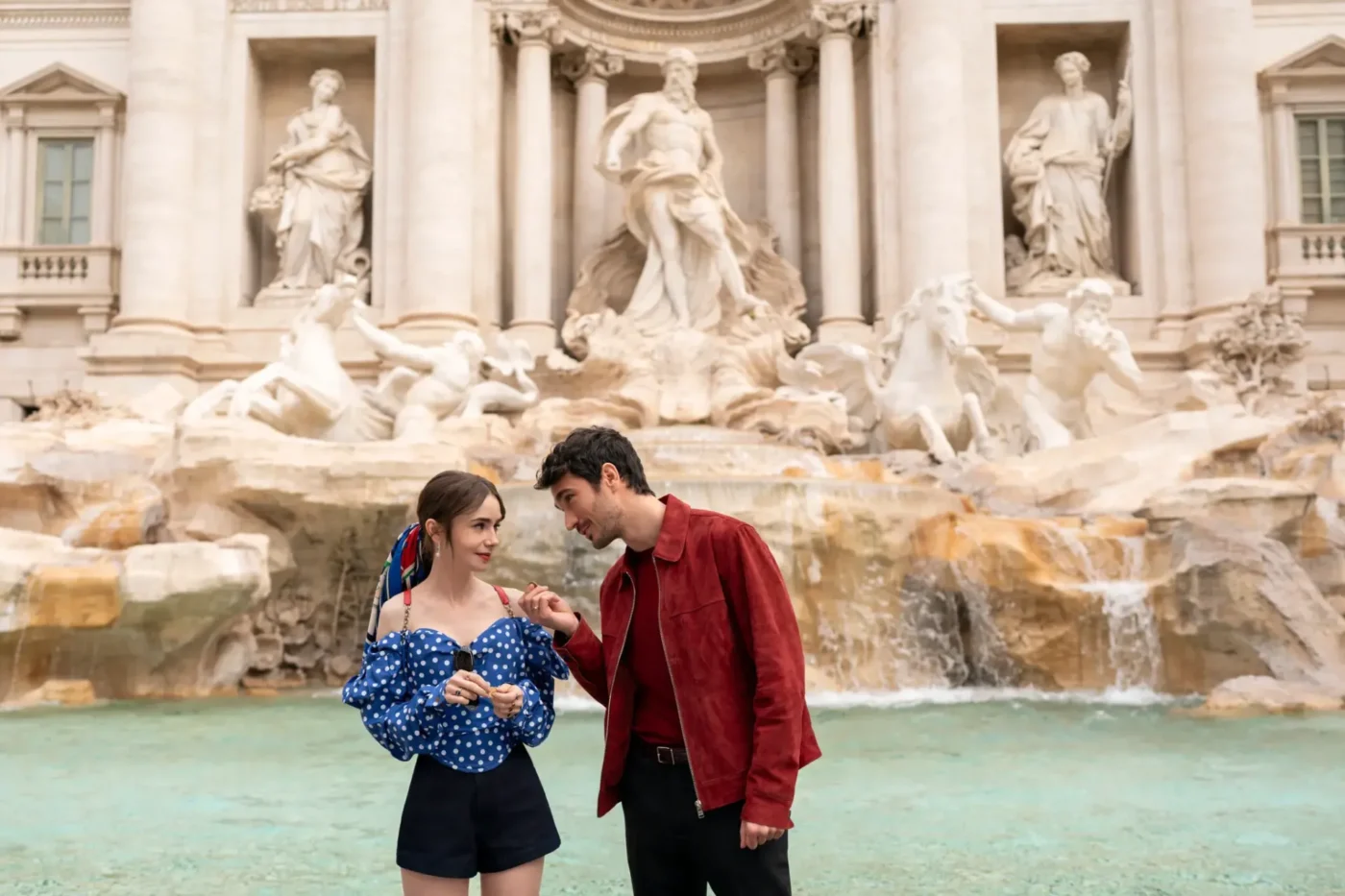I’m ashamed to say that it’s taken me this long to watch the second half of Emily in Paris, set, coincidentally, in Rome, because I wasn’t sure if I could bear it. It was bad enough to watch the trailer, in which Emily strolls through the streets of the city center, rendered in achingly beautiful detail and awash in a stunning golden light. She could at least be visibly sweating, I thought. Waiting for a bus that never comes? Something that offered some hint of realism, of the reality of what it is to live here.
Ironically, the parts of the show that have always felt most unrealistic to me are the professional scenes. In many ways, Emily in Paris is essentially a soapy office drama, a procedural in which every work crisis is resolved with Emily as the heroine. Her older, French compatriots somehow always end up spouting a version of: “yes, strangely-dressed millennial princess, we renounce all of our preconceived notions about what PR and marketing mean and we bow to your newfangled ideas!” This is the sort of wish-fulfillment I have always imagined for myself with editors, though it has yet to pan out.
But Emily in Paris has never dealt in reality—it was my mistake to expect something that was never even on offer. (This is the problem of most entertainment.) And so, when a friend of mine implored me to watch the season so we could “discuss,” I decided that I would put aside the looming existential trauma of watching a fantasy of what my life could be (and most decidedly is not) in favor of a sort of Clinical Research. If anything, I was intrigued to see the modernized American ideal of Rome in a show that has largely trafficked in stereotypes.
Our Emily in Paris tour of Rome unsurprisingly starts by taking us past a few of the city’s key landmarks. There’s Piazza di Spagna, in which Marcello (Eugenio Franceschini, with the La Dolce Vita reference) and Emily (Lily Collins) sit on the Spanish Steps, actually a violation of local law. There’s the view of the Fontana di Trevi emerging from an alleyway, its marbled surroundings uncharacteristically not filled with people. (In my more than two years in Rome, I’ve never seen it that way.) There’s the trademark Vespa ride by the Colosseum, which, I hate to say, is really as moving and heart-stopping as they portray it.
As for what it means to be Italian, the series relies on well-worn ideas: punctuality isn’t that important. (This is not always true.) You shouldn’t drink cappuccino after 11 AM. (Again, a good rule of thumb for a tourist, but not always true.) In Rome, everyone knows everyone. (This is almost certainly true, at least as it relates to individual neighborhoods. Once you’ve been there long enough, people will just come up to you on the street and ask who you are and why you’re there.)

Emily (Lily Collins), Gianni (Flavio Furno), and Marcello (Eugenio Franceschini) in episode 409 of Emily in Paris. Cr. Giulia Parmigiani/Netflix © 2024
And then, without fail, out comes the number one cliché abroad of Italian culture: Italians *~enjoy life~*. This is, of course, both true and untrue. Italians have a presentness built into their culture, but daily life here is also a constant melodrama, like when I watched a woman declare “This is truly hell we’re living in” as she got on the 8 tram only to find out it had been replaced by a bus for the entire summer. Flash forward two years later, and it’s still a bus, but I digress.
But the scene that got the most nodding-alongs from me vis-a-vis Italian culture actually took place in Paris, when Emily’s phone dinged with constant messages from her paramour. Italian men are nothing if not incessant and persistent, especially in the “courting period,” which often has nothing to do with how much they like you and is just somewhat of a cultural norm. As someone who hates constant texting throughout the day, this has always been a struggle for me, particularly when they hit you with: “Ehi” or “Daiiii, why don’t you respond?” To extend a dinner invitation, a man once called me almost 20 times in one day. Another man saw a photo from my Instagram story in his city and asked where I was. “I’m about to leave,” I told him, lying by an hour. “Are you at the train station now? I’m right nearby! I’ll meet you there,” he responded. I proceeded to spend the next 15 minutes trying not to look at every passerby for fear they might be him. I can see how the persistence might seem romantic, but when you start to realize how little it has to do with you and how much it has to do with performing some kind of modern idea of courtly love, it actually becomes depressing, like can you ever parse someone’s true feelings for you? But, again, I digress.
These were, alas, the only glimmers of my daily life that I ever saw reflected in the show. As I watched Emily stroll through the city’s bougainvillea-trellised streets of Rome, what struck me most was how it resembled more of a film-set than it ever does in real life. This is what an American camera trained on the city can do—even the lighting feels oversaturated. This was Rome, Disney World edition, Hollywood-style, robbing the city of everything that was organic and rugged and almost grotesque about it and trading it instead for wide shots of rosy-hued alleyways. What makes Rome so beautiful is the fact that the trash and the ruins and the screaming of “Aooo” coexist with this kind of sepia-tinged charm. Rome, for me, has never been the kind of beauty that gets picked out of a crowd, but instead the kind that might come to you slowly, staring at someone’s face across the table, cataloging their various features. The contrast is the thing, but that nuance here was lost.

Just as I was about to give up on salvaging any piece of my beloved city in the patchwork of generic Italian passeggiate and Colosseum drone shots, the show’s arguably best character, Sylvie, head of Agence Grateau, managed to surprise me. In a scene with her Italian lover–a famed director (played by Raoul Bova, from, among many other things, Under the Tuscan Sun)–he notes that Sylvie is continually drawn back to the city, and it’s not only because of him. They met when she took a filmmaking class in Rome as part of her “midlife crisis.”
“This city has a hold on you, or maybe it represents who you really want to be,” he tells her. They’re walking on the Via Veneto, the lights of Harry’s Bar flashing in the background, a reminder of a different era of Rome.
“And what is that?” She asks him.
“An artist, a filmmaker,” he responds. The point of the exchange is to reiterate Rome as the “we live for the sake of living” antidote to the show’s version of Paris, which is ostensibly all work compared to Rome and all play compared to the United States and just goes to show that life is a study in relativity.
Whatever the show’s intentions, I saw some sort of essential truth in what Bova was saying, not in living the American fantasy of what Rome could be, but in living its reality. Rome, after all, has inspired legions of foreign artists—Angelika Kauffmann, John Keats, Goethe, Henry James, even Eve Babitz. In James’ The Portrait of a Lady, protagonist Isabel Archer finds herself struck by the city, a place of “endless interest” where there’s “history in the stones of the street and the atoms of the sunshine.” Babitz, who was about as far from James as one can be, unflappable and desirous, loved Rome for its sheer implausibility, the way it reminded her, oddly enough, of Los Angeles, with its “false but gorgeous fronts and tawdry tears.”
But these are all just descriptions of Rome, of the city’s makeup. What Bova captured was its very essence. I understood what he meant, because Rome had given me that too, had helped me to see myself as who I imagined myself to be and not only in the roles I had found myself placed into. Rome had taught me that the tentative murmur inside of me that had always said, “You might be a writer,” deserved to be turned up a notch.
Perhaps Sylvie had already realized something that Emily, in her unending earnestness, never could. Cities have the power to tell us things. Our task is merely to listen.







